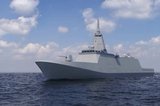Steel cut on Royal Navy's HMS Cardiff frigate
BAE Systems has cut steel for the second of the Royal Navy’s Type 26 City-class Global Combat Ships, HMS Cardiff.
This marks an important milestone in the programme to deliver the new anti-submarine warfare vessel to the Royal Navy.
A traditional steel cutting ceremony at BAE Systems’ shipyard in Govan on the River Clyde was attended by the company’s employees and representatives from the navy on 14 August, and Anne-Marie Trevelyan, minister for defence procurement, performed the official duties of setting the plasma cutting machine to work on a plate of steel that will form part of the unit that holds fuel stores for the ship.
The City-class Type 26 frigate is designed to carry out critical protection of the UK’s submarine-based nuclear deterrent as well as the carrier strike group, ultimately replacing the RN’s Type 23 frigates.
Each Type 26 will be equipped with a range of capabilities including the MBDA Sea Ceptor missile defence system, a 5-inch medium calibre gun, flexible mission bay, Artisan 997 medium range radar, bow and towed array sonars, and a vertical launch silo capable of hosting a variety of weapons.
The ceremony to mark the formal start of manufacture on the second of the Type 26 comes two years after steel was cut on the first in class, HMS Glasgow.
Momentum on the development of HMS Glasgow continues, with over one half of the ship now in production, remaining on track to enter service in the mid-2020s.
BAE Systems has now marked the start of construction of seven warships for the RN in just five years, including five River-class offshore patrol vessels (OPVs).
All five OPVs are now in the water, with the first, HMS Forth, already in active operation with the navy.
‘The Royal Navy's new world-beating Type 26 anti-submarine frigates are truly a UK-wide enterprise, supporting thousands of jobs here in Scotland and across the UK,’ Trevelyan said.
‘These ships will clearly contribute to UK and allied security, but also make a strong economic contribution to the country. With 64 sub-contracts already placed with UK-based businesses, there will be new export opportunities for them to tender for through the selection of the Type 26 design by Australia and Canada too.’
The Global Combat Ship helps bolster the partnership between the Royal Navy, Royal Canadian Navy and the Royal Australian Navy, all of which have selected a variant of the Type 26 design for their anti-submarine frigate programmes.
Related Equipment in Defence Insight
More from Naval Warfare
-
![NATO tests use of “undetectable, jam-proof” laser communication in maritime scenarios]()
NATO tests use of “undetectable, jam-proof” laser communication in maritime scenarios
As part of its effort to better prepare its capabilities for operations in contested and congested scenarios, NATO evaluated a Lithuanian ship-to-ship terminal designed to not be susceptible to enemy interference.
-
![Mitsubishi eyes future with Australia’s Mogami selection]()
Mitsubishi eyes future with Australia’s Mogami selection
With Australia’s selection of the Mogami-class for Project Sea 3000, Mitsubishi is investigating local production in the next decade as potential export opportunities emerge.
-
![Thales’ new Sonar 76Nano could equip UK Royal Navy on anti-submarine warfare missions]()
Thales’ new Sonar 76Nano could equip UK Royal Navy on anti-submarine warfare missions
The new sonar is designed to equip uncrewed underwater vessels, with the potential to be used by the Royal Navy for its Atlantic Bastion and Atlantic Net missions.





















